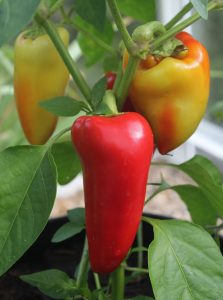Now that greenhouse tomatoes are growing rapidly, remove the side shoots of ‘cordon’ varieties, as they appear, using your finger and thumb, to create a single productive stem to train up the cane. Keep the compost constantly moist using tepid water, checking regularly, particularly if you use growing bags as the compost dries out rapidly – up to two or three times a day, depending on the weather. Erratic watering causes calcium deficiency which appears as ‘blossom end rot’, later in the season, when the end of the fruit furthest away from the stem, collapses and turns black. Don’t compost the fruit, just cut off the damaged end and eat the undamaged part of the tomato. Feed with Epsom Salts at one teaspoon per gallon at the first signs of leaf yellowing to avoid magnesium deficiency and once the plants have set fruit, give them two or three feeds with general fertilizer to boost their health and vigour, changing to high potash tomato fertilizer for the rest of the season while maintaining moisture levels in the compost to stop them from splitting.
There is still time to sow sweetcorn in pots modules or recycled waxed paper drinks cups with a hole in the base, planting one seed per pot as they resent root disturbance. Sow them in peat free multipurpose compost. Plant in blocks rather than rows as it is wind pollinated.

As temperatures rise, introduce biological controls to control pests; the predatory wasp Encarsia formosa for whitefly, predatory mites Phytoseiulus persimilis and Amblyseius, a predatory midge Feltiella acrarsuga and a rove beetle Atheta coriaria for red spider mite. Control mealybug, with the ladybird Cryptolaemus montrouzieri. Check your plants regularly for signs as it is easier to control smaller infestations than an epidemic.
To stop the glasshouse overheating, ventilate as temperatures rise during the day before they overheat. Small glasshouses heat up rapidly, so make sure that there are enough roof vents and louvres in the sides for ventilation – large glasshouses need a 1:5 ratio of metre square floor area to ventilation; smaller glasshouses need more. If the mornings are cool, start by opening the vents, then the side louvres and leave the door until last, especially in the UK where sunny weather is often accompanied by cool easterly winds.
Keep potting on Aubergines, peppers and chillies into pots one or two sizes larger using either peat free multipurpose compost or peat free multipurpose with added John Innes, do this once they have formed a good root system but before they become pot bound. The final move should be into a 23 cm pot or two plants per growing bag for extra rooting space. Keep a bucket or bag of compost, or the growing bag in the greenhouse for 24 hours beforehand so it is warm for transplanting.
Pinch out the tips from the main stems of aubergines when they are 30-40cm tall. Stake or tie into supports as they grow. Pinch out the growing tip of peppers and chillies when they are about 15cm to encourage branching and heavier cropping. Happy Gardening. Matt


